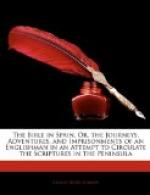The Soc de Barra is an open place beyond the upper wall of Tangier, on the side of the hill. The ground is irregular and steep; there are, however, some tolerably level spots. In this place, every Thursday and Sunday morning, a species of mart is held, on which account it is called Soc de Barra, or the outward market-place. Here and there, near the town ditch, are subterranean pits with small orifices, about the circumference of a chimney, which are generally covered with a large stone, or stuffed with straw. These pits are granaries, in which wheat, barley, and other species of grain intended for sale are stored. On one side are two or three rude huts, or rather sheds, beneath which keep watch the guardians of the corn. It is very dangerous to pass over this hill at night, after the town gates are closed, as at that time numerous large and ferocious dogs are let loose, who would to a certainty pull down, and perhaps destroy, any stranger who should draw nigh. Half way up the hill are seen four white walls, inclosing a spot about ten feet square, where rest the bones of Sidi Mokhfidh, a saint of celebrity, who died some fifteen years ago. Here terminates the soc; the remainder of the hill is called El Kawar, or the place of graves, being the common burying ground of Tangier; the resting places of the dead are severally distinguished by a few stones arranged so as to form an oblong circle. Near Mokhfidh sleeps Sidi Gali; but the principal saint of Tangier lies interred on the top of the hill, in the centre of a small plain. A beautiful chapel or mosque, with vaulted roof, is erected there in his honour, which is in general adorned with banners of various dyes. The name of this saint is Mohammed el Hadge, and his memory is held in the utmost veneration in Tangier and its vicinity. His death occurred at the commencement of the present century.
These details I either gathered at the time or on subsequent occasions. On the north side of the soc, close by the town, is a wall with a gate. “Come,” said the old Mahasni, giving a flourish with his hand; “Come, and I will show you the garden of a Nazarene consul.” I followed him through the gate, and found myself in a spacious garden laid out in the European taste, and planted with lemon and pear trees, and various kinds of aromatic shrubs. It was, however, evident that the owner chiefly prided himself on his flowers, of which there were numerous beds. There was a handsome summerhouse, and art seemed to have exhausted itself in making the place complete.
One thing was wanting, and its absence was strangely remarkable in a garden at this time of the year; scarcely a leaf was to be seen. The direst of all the plagues which devastated Egypt was now busy in this part of Africa—the locust was at work, and in no place more fiercely than in the particular spot where I was now standing. All around looked blasted. The trees were brown and bald as in winter.




